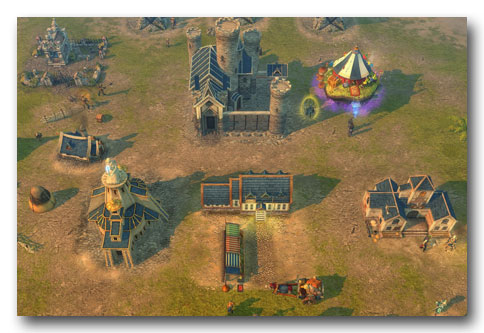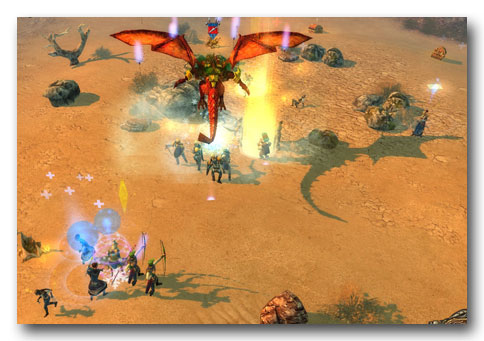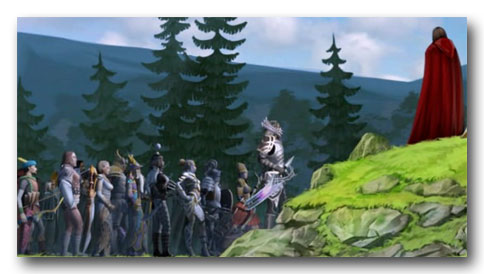
Playing Majesty 2: the Fantasy Kingdom Sim is like watching an impersonation. In exceptional cases like Andy Kaufman’s masterful send-up of Elvis, the impersonator could be so good it’s impossible to return to the original without recalling the ersatz version, but with most there’s always the niggling sense in the back of the mind the imitator is merely exploiting the original’s cachet.
Majesty 2, the Ino-Co-developed sequel to Cyberlore’s unusual real-time strategy title, is a decent enough impersonation both in presentation and gameplay. The Sean Connery-sound-alike royal adviser returns and the tax collector mimics Paul Lynde once again (though not always successfully – “Tex-x-x collector!”), and some of Majesty 2’s campaign missions take inspiration from the first game’s expansion.
In some respects, it must be said Majesty 2 is actually better. Yet the improvements made suggest the well-meaning Russian developer missed the true import of the first game and would have been better off doing its own thing instead of inviting unflattering comparisons.
The original Majesty was a design so unusual Cyberlore had trouble finding a publisher for the game even during the great RTS glut of the late Nineties.
On the face of it, Majesty was a conventional RTS. Players start with a base, explore the map, improve the economy, expand the base, pump out units and exterminate enemies. However, RTS games tend to be about strict control with victory hinging upon outproducing opponents by increasing actions per minute to ensure maximum resource collection efficiency and production output. (These are the ideal games for aspiring factory supervisors.) The manufactured products in these games are anonymous soldiers with no sense of self-preservation who will conveniently do or die without question.
Majesty’s major break with RTS convention is that players do not have direct control of their units. To influence units (politely referred to as “heroes” in the game but more accurately described as private military contractors), players offer bounties for tasks that need to be accomplished: say, 200 gold to whoever ventures to that unexplored area of the map or 400 gold for the head of the Troll attacking the Marketplace. These bounties are offered via the cunning use of flags and Majesty’s gameplay frequently boils down to monitoring the mini-map for hotspots then planting attack flags on aggressors. While it may seem like whack-the-mole with flags, it’s really more flag-the-mole with the actual whacking delegated to heroes.
The thing that made Majesty charming and exasperating in equal measure is the heroes, unique and unpredictable, are not necessarily disposed to do what is required of them. A Warrior might rub his hands gleefully at the prospect of gaining 400 gold, make a beeline for the Troll, take a long hard look at it then decide 400 gold really wasn’t worth the risk. This could be absolutely infuriating when it occurred during a critical moment (for instance, when the Marketplace vital to the economy was about to be levelled) but this was what made Majesty Majesty: the lack of control over independent heroes.

The feature that distinguishes Majesty 2 from its predecessor, on the other hand, is control and this could only be construed as an improvement if the lack of control in Majesty was perceived as a flaw rather than a feature.
The inclusion of additional flags in Majesty 2 is obviously meant to give players greater influence over the capricious heroes. The Protection flag encourages heroes to guard vulnerable buildings and characters while the Fear flag discourages vulnerable low-level heroes from casually sauntering into danger. Anyone who’s played the original game and groaned as heroes belatedly responded to dire threats will immediately recognise the benefits of these new flags.
There are additional crutches that make the sequel much less frustrating: the Hall of Lords allows high-level heroes to be reused in subsequent missions; Trading Posts have defensive upgrades which helps them survive long enough for heroes to arrive; the Inn now allows the formation of parties in the classic D&D tradition, which means frail Wizards can be safeguarded by healers and tanks; and the Graveyard makes it much easier to resurrect fallen heroes compared to Majesty’s Mausoleum.
All those are clear signs Ino-Co made a genuine effort to fix the problems of the original game but the developer would have been better off accentuating Majesty’s strengths.

Ino-Co’s changes, though well-intentioned, have reduced the role and the influence of the heroes. One simple but clear indication of this is heroes are now no longer a prerequisite for expanding the castle.
The Artifacts, player-activated items obtained during the campaign, are another indication. The Orb of Sidrian boosts the economy, the Mantle of Teevus heals heroes, the Scepter of Sidrian damages opponents and the Crown of Ardania provides a temporary distraction. Those are all tasks that could have been performed by the heroes if they were given greater emphasis.
What is particularly disappointing about Majesty 2’s heroes is their behaviour has been simplified to the extent the differences between classes are less pronounced. The Dwarves, for instance, no longer repair buildings, making them little more than short, stocky Warriors. Moreover, it’s no longer necessary to make hard choices between the different classes as they all coexist peacefully now — Dwarves and Elves, Paladins and Priestesses of Krypta, side by side with nary a complaint.

By streamlining hero behaviour and abilities, and deemphasising their role in the game, Ino-Co has diminished one of Majesty’s simple joys: watching the heroes go about their business. Indeed, this was the raison d’être for the original game as the lead designer conceived it after watching a Settlers II unit wander off on its own. Majesty 2’s biggest problem is its heroes, the sims at the heart of this fantasy kingdom simulation, are just not captivating enough.
Majesty 2 may be a decent impersonation but Ino-Co had a great opportunity to build on Majesty’s strengths and failed to take it. The ultimate realisation of the Majesty concept will be an eccentric mix of RTS, D&D and The Sims, and Majesty 2 falls well short of that ideal. By giving players greater control, Ino-Co has brought the game closer to a conventional RTS when the design should have been taken further down the sim path. If Majesty 2’s heroes were imbued with more personality, more individuality and greater purpose, the game could have been the sequel so good no one would ever bother with the first game again. As it is, the best that can be said of this imitator is that it ought to inspire players to rediscover and better appreciate the original.
